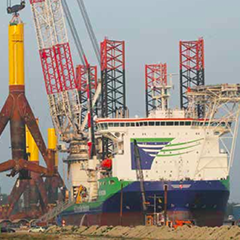In this issue, we turn our attention to Vlissingen – a bustling commercial base that’s high on the strategic agenda for wind executives throughout Europe.
The North Sea is an ideal location for the generation of wind energy. The wind is favourable and thanks to the slight water depths it is relatively easy to build large wind parks here. Not surprisingly, quite a few offshore wind projects are planned. Projects that require a lot of materials that need to be shipped in by sea. The port of Vlissingen, part of Zeeland Seaports, is an ideal home base for delivery for wind-energy projects, but also for oil and gas production activities.
Strategically located
The location is a strong point. Vlissingen is close to the North Sea and is favourably located in relation to the Netherlands, Belgium, the north of France, the United Kingdom and even Germany and Denmark. In front of the coasts of these countries, major wind parks will be developed over the coming years. In addition, the port is very well accessible.
Broad installation vessels can navigate freely, unencumbered by locks or bridges. This is important because what is true anywhere, is true for this branch especially: time is money. For the transport of heavy loads, special ships are needed, which can only bring along a limited amount of material each time. Therefore, speedy handling is of the utmost importance.
Space and facilities
Space is another plus of the Vlissingen location. Many wind generator parts are manufactured in the hinterland, for example in Limburg. These types of companies often look to Zeeland Seaports for the temporary storage of monopiles, transition pieces and similar.



























